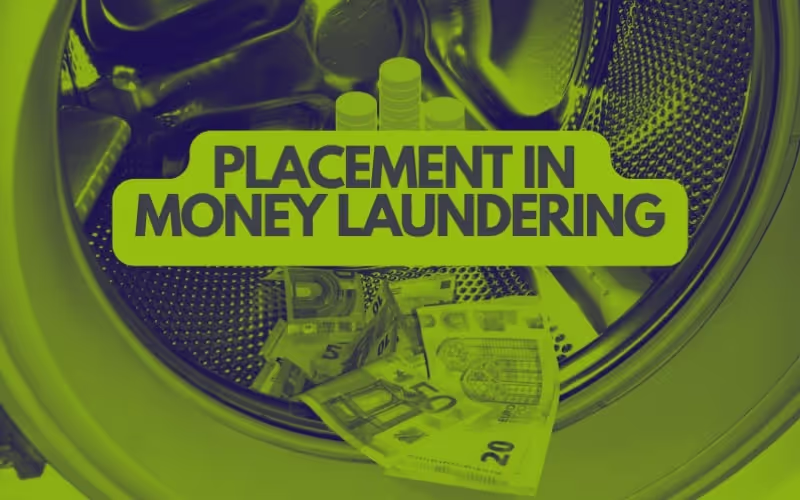
The Elusive Placement Stage of Money Laundering Explained
This article dives into the placement stage of money laundering - the first step criminals face in cleaning dirty money. Traditional methods, such as cash-based businesses, continue to launder money worldwide. But we'll also examine how cryptocurrencies offer a new way for black money to enter the legitimate financial system.
Money laundering is an illegal practice that has infiltrated the global financial system, costing an estimated 2 to 5 percent of global GDP yearly, or roughly $800 billion to $2 trillion.
Criminal organizations rely on a sophisticated process of moving money through the three stages of money laundering: placement, layering, and integration. In this post, we will focus on the placement stage and take a deep dive into how it operates.
This is what the article will cover:
- The Placement Stage of Money Laundering 101
- Basic Example of the Placement Stage of Money Laundering
- More Complicated Techniques Used in the Placement Stage
- Cryptocurrencies & the Placement Stage of Money Laundering
The Placement Stage of Money Laundering 101
It's all too easy to over-complicate money laundering. So let's put it into layperson's terms. Criminals have accumulated cash from illegal activities for hundreds of years. And today, it's still the same: Cash is king.
From drug traffickers to prostitution rings, criminals amass bags of notes and coins from their nefarious money-making schemes.
And it creates practical problems. First, physically storing large amounts of cash is never a good idea, especially for individuals operating in the underworld. Secondly, since it is possible to clean dirty money, it's common sense to launder it. That way, criminals also remove themselves further from the initial crimes that made them their profits.
With that in mind, in the placement stage of money laundering, criminals attempt to insert those bags full of dirty cash into the legitimate financial system.
And often, that's precisely what they are doing - for example, in 2021, the UK bank Natwest was fined £264 million after taking deposits of illicit cash in black bin bags over five years.
But it is important to note that criminals don't funnel all unlawful funds into the placement stage of money laundering.
This is because dirty money can also serve other purposes, such as funding bribes or compensating associates involved in illegal activities. Also, not all criminal activities create physical cash to launder - as with cybercrime.
A Basic Example of the Placement Stage of Money Laundering
Let's delve a little deeper into the placement stage of money laundering by looking at a simple example: Criminal proceeds entering the banking system as cash deposits.
This first stage is the riskiest for money launderers because they directly deposit illicit funds into the legitimate financial system.
And banks have legal obligations to report to authorities suspicious cash deposits through a Suspicious Activity Report (SAR). Technological advances in RegTech software financial institutions use to detect money laundering also makes it harder for criminals to evade detection.
However, like with the NatWest example, global financial giants still get caught out.
HSBC's Money Laundering Scandal
One of the most infamous placement stage cases of money laundering with cash deposits involves HSBC. It's become a textbook example already on finance-related courses' syllabi worldwide.
This is what happened: Between 2006 and 2010, HSBC branches in Mexico became the bank of choice for drug cartels and their money laundering activities. It's unfathomable to imagine, but one of the world's largest banks allowed $881 million to enter its banking system because compliance was 'woefully inadequate,' according to the US Justice Department.
And if you want a tangible image of placement in money laundering, this is it. Because every day, traffickers deposited cash using custom-made boxes that fitted the exact dimensions of the tellers' windows at HSBC branches in Mexico (to deposit the maximum they could in one hit).
In 2012 HSBC agreed to pay a $1.9 billion fine for breaking US anti-money laundering (AML) regulations regarding the breaches in Mexico and other banking lapses.
Complicated Techniques Used in the Placement Stage
We already know that the placement stage of money laundering involves placing dirty money into the legitimate financial system, such as cash deposits into a bank.
But it gets more complicated because money launderers use various techniques to mitigate the risk of getting caught by law enforcement and compliance systems used by financial institutions.
Here are the most common techniques:
Smurfing & Structuring
The sanctions.io blog discussed smurfing & structuring in the placement stage of money laundering. Although different, both techniques involve breaking large amounts of unlawful funds into smaller parts to minimize detection. The HSBC Mexico case involved smurfing and structuring by drug cartels - remember the custom-made boxes used for daily cash deposits.
Smuggling
Criminals may transport cash across borders to deposit it in another country's financial system. Often this happens by identifying a specific bank (or branch) as having weaker compliance controls. In the HSBC Mexico case, traffickers smuggled packages of illicit cash proceeds from the US illegal drug trade into Mexico in trucks - the dirty money eventually being deposited into HSBC Mexico branches.
Money Mules
Money mules, who are often unaware of their involvement in unlawful activities, use their bank accounts to transfer illegal money on behalf of criminals. Also known as squaring, criminals often recruit money mules through fraudulent job offers or romance scams. The placement stage of money laundering occurs when the illicit funds enter the money mules' bank accounts (where the layering stage begins).
Purchasing high-value assets
Criminals can purchase high-value assets, like luxury cars, real estate, artwork, diamonds, and gold, in large cash deals. The placement stage of money laundering occurs when the money launderers sell on the expensive goods - with payment received electronically and thus entering the financial system seemingly legitimately. The sanctions.io blog wrote about this technique in this post regarding luxury vehicles.
Cash-Based Businesses
Criminals can buy cash-based businesses (e.g., laundromats, restaurants, bars, convenience stores, and casinos) to deposit illegal cash into the banking system. They blend the illicit funds with legitimate income from the company, making it harder to detect the source of the money.
The 2019 movie The Laundromat uses a laundromat as a metaphor for the complex and interconnected system of shell companies, law firms, and financial institutions used in global money laundering schemes.
Shell Companies
Not all illicitly-gained funds enter the legitimate financial system in the placement stage as cash.
Criminal networks also use shadowy shell companies in jurisdictions with weak financial regulations and secrecy laws. Dirty money enters into a shell company's bank account controlled by the criminal - it's then wired to a legitimate business, also controlled by the crime group, where it appears as revenue.
The sanctions.io blog discussed how this problem is being tackled in a post about KYCC (Know Your Customer's Customer).
Cryptocurrencies & The Placement Stage of Money Laundering
We'll now examine a newer method criminals embrace: Crypto money laundering. And here is a shocking statistic: Chainalysis reported that in 2022, $23.8 billion in digital currency was transferred through illicit addresses, representing a 68% increase from the previous year.
To be precise - that statistic covers all stages in the money laundering process. And a percentage of that sum will come from illegal funds earned through cybercrime (where there is no physical cash). But still, plenty of dirty physical money earned through illicit activities is transferred to crypto by criminals.
So how does crypto in the placement stage of money laundering work?
Peer-to-Peer (P2P) Transactions
One method for criminals to change physical cash into cryptocurrency is through peer-to-peer (P2P) transactions. It involves finding a seller willing to exchange cryptocurrency for cash. The transaction can take place in person or through a trusted intermediary who can facilitate the exchange.
Bitcoin ATMs
Another way is using Bitcoin ATMs, which allow individuals to buy and sell Bitcoin and other cryptocurrencies using cash. Criminals can use these Bitcoin ATMs to deposit illegally-gained physical money and receive cryptocurrency in return.
Bitcoin ATMs and exchanges are under a constant flux of rules and regulations in different jurisdictions. Criminals share locations of Bitcoin ATMs with weaker compliance and information about unregulated crypto exchanges over networks like the dark web.
The cryptocurrency now held by the criminal will then enter the layering stage of money laundering using methods such as cryptocurrency mixing.
Learn More About Money Laundering
You can learn about the three stages of money laundering and what businesses should do to combat money laundering on the sanctions.io blog.
To find out more about ways to detect and prevent money laundering within your organization, contact sanctions.io for an obligation-free discussion. We enable intelligent AI-powered sanctions, PEP, and criminal watchlist screening for your AML, KYC & trade compliance screening needs.



